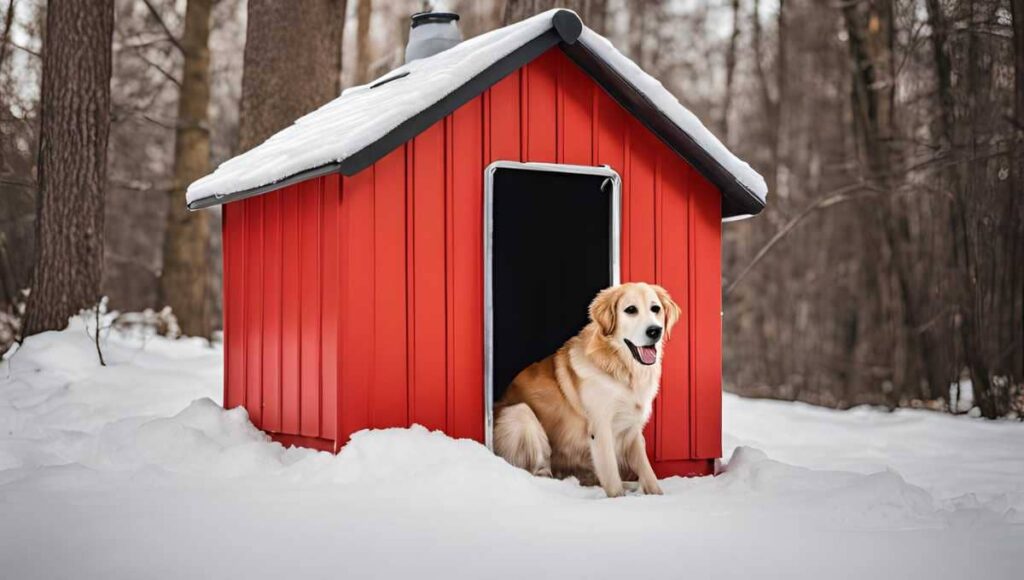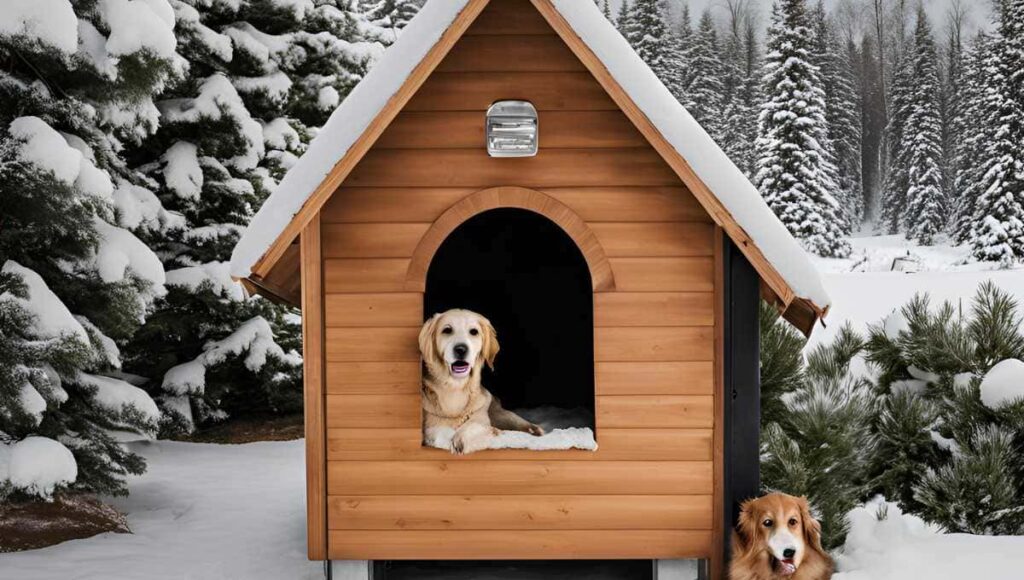
Introduction
Ensure your dog’s warmth this winter with a heated dog house. Learn about insulated and electric options to keep your pet cozy and safe.
When it gets cold, you need to keep your dog warm inside and outside. Some dogs do well in cold weather, while others like to stay warm indoors. No matter what kind of dog you have, getting a heated dog house is a good idea if your dog stays outside in winter.
In This Post
ToggleHeated dog house
When we talk about heated dog houses, we don’t mean those heated with electricity. Instead, we mean dog houses with lots of insulation and other ways to keep heat inside, making them cozy for your dog. Some use electricity, but most rely on insulation.
When you have to use a heated dog house
Dog houses are useful for many pet owners. If you have a fenced yard and are at work most of the day, leaving your dog outside can be better than keeping them in a crate.
In the summer, you can leave your dog outside with enough shade and water. But in winter, you may need to heat their dog house. Heated dog houses have insulation to keep your dog warm outside in the cold.
When should you use a heated dog house?
- Not all dogs need one.
- If your dog is only outside for walks in the snow and not for long periods, you might not need a heated dog house.
- If you have an arctic dog breed, you probably don’t need to heat their dog house.
- However, if you live in a place with extremely cold weather, an insulated dog house can still be useful for these breeds.
- You do need a heated dog house if your dog doesn’t handle cold weather well.
- Dachshunds, Chihuahuas, Basset Hounds, Greyhounds, Doberman Pinschers, Chinese Crested, Whippets, Yorkshire Terriers, Pit Bulls, and French Bulldogs need to stay warm and healthy.
If you must leave your dog outside in the winter, a heated dog house will keep them safe, warm, and happy.

Some types of heated dog house
Though heated dog houses come in many shapes and sizes.
there are only two main types:
- electrically heated dog houses
- insulated dog houses.
Most dog houses aren’t truly “heated.” These houses use insulation to keep warmth in and cold out. They are more effective in very cold weather, but they come with risks. If your dog chews the wiring or if the heating malfunctions, your dog could be stuck in the cold or face dangers like electric shock or burns.
What you have to know for a heated dog house
Adequate space
- First, make sure the dog house has enough space.
- While heating a larger area uses more energy than a smaller one, your dog needs enough room to lie comfortably.
- A good rule of thumb is to get a dog house that’s 25% larger than your dog’s length from tail to nose.
- This provides enough space for them to move, lie down, and sit comfortably without the house being too large.
Right temperature
- If you’re providing a warm dog house for your dog in cold weather, it’s important to maintain the right temperature.
- If using electric heating, aim to keep the dog house between 69 to 73 degrees Fahrenheit.
- This temperature range is comfortable for most dogs, especially toy breeds or puppies who need extra warmth.
Weather material
- The cold weather isn’t the only weather you need to protect your dog from during winter.
- Sleet, snow, and cold rain can be dangerous for your pet if they’re left outside.
- Make sure the heated dog house you choose has weather stripping or weatherproof material to keep your pup nice and dry inside.
How to heat your dog house safely?
With summer over, it’s important to heat your dog house to keep your pet warm safely. Here are some tried-and-true methods to heat an outdoor dog house:
Temperature-Controlled Heating Pads
The safest and most efficient way to heat your dog’s house is with a temperature-controlled heating pad. Unlike other heating pads that can be dangerous, models like the Stanfield dog heating pad are designed for pets. They distribute heat evenly and are made with high-quality, insulated materials, making them safe and durable.
Hay Bedding
A cost-effective way to keep your dog house warm is with hay. Layers of hay on the floor help keep your dog warm when it’s cold outside. If you use hay, change it every two days to keep it clean. If you use a heating pad, hay bedding isn’t needed.
Insulation & Carpeting
Insulating your dog house helps retain heat. Use insulation like that in your attic or garage for the walls and roof. You can also carpet the dog house for extra warmth.
Electric Heater
If cost isn’t an issue, you can use an electric heater designed for dog houses. These maintain a comfortable temperature all winter. Don’t use space heaters meant for human houses, as they can be fire hazards in a dog house. Heating units for dog houses are rare and expensive, so most people prefer heating pads.
Solar Powered
For an eco-friendly option, you can install solar panels on your dog house. This is another costly option, but it provides a sustainable heating source for your pet.

Top heated dog house on the market
- Dog Palace Insulated Dog House
- K&H Pet Products Outdoor Heated Multi-Kitty House
- K&H Pet Products Thermo-Tent Outdoor Heated Pet Shelter
When a heated dog house isn’t enough for your pet
While rare, there are times when a heated dog house isn’t enough to keep your dog warm. If your dog is sensitive to the cold or you live in a very cold area, take extra steps to keep them warm. Moving your dog inside during winter is also a good option.
Consider using heated dog beds, dog sweaters, and electrically heated dog houses if your dog must stay outside. Ensure your dog gets proper nutrition with healthy amounts of protein and fats to help them stay warm.
5 step for maintaining heated dog house
Disinfect the Entire House
Regularly disinfect your dog’s house to prevent fleas, ticks, and allergies. Keeping the dog shelter clean also ensures your home stays germ-free. You can find various disinfectants in the market. If you use a bleach solution, mix one part bleach with thirty-two parts water. After using bleach, rinse the surfaces to avoid chemical residue and inhalation.
Regularly Clean Accessories and Materials
Empty and clean the water bowl, food bowl, toys, and sheets or blankets regularly. Sunlight can kill most germs on sheets and blankets, reducing the need for frequent washing. Dogs often bring foreign objects into their kennel, so remove these to keep the inside clean and prevent germ infestation.
Provide a Cold-Proof Layer
If you live in a cold area or have harsh winters, give your dog extra protection. Warm their indoor bed if they lie directly on the cold floor, or make an elevated bed. Avoid using metal or concrete for the floor. Consider using a hot water bottle or a microwavable heating pad that stays warm for up to 12 hours. Heated water and food bowls are also good options. You can add an inner wall for insulation and use plastic or flaps for the door to keep the cold out.
Check for Leakages
Over time, dog houses can develop leaks due to wear and tear, which can be problematic during rain, winter, and wind. Remove old shingles and sub-roofing, add insulation, lay down a water-resistant membrane, and then re-shingle. You can also use a waterproof coating or cover for the house.
Upgrade or Improve the Doghouse Every Year
While you should clean the dog house every week, it may need upgrades or maintenance to stay safe, clean, and hygienic. Plan a major upgrade once a year.





